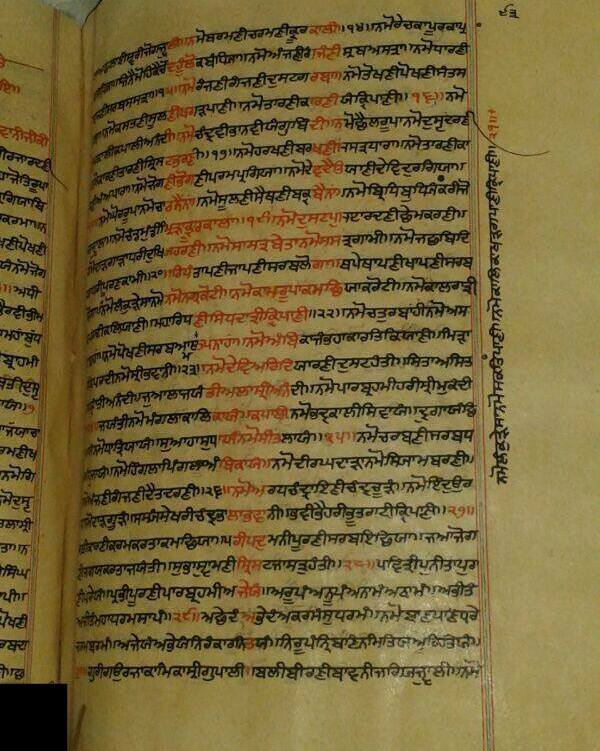Chandi Charitar Ukati Bilas on:
[Wikipedia]
[Google]
[Amazon]
''Chandi Charitar Ukti Bilas'' or ''Chandi Charitar Ukat(i) Bilas'' ( pa, ਚੰਡੀ ਚਰਿਤ੍ਰ ੳਕਤਿ ਬਿਲਾਸ, lit=enjoyment of the recitation of Chandi's deeds, pronunciation: ), also called Chandi Charitar 1 (ਚੰਡੀ ਚਰਿਤ੍ਰ (ਭਾਗ ੧)) or Chandi Charitar Part One is a heroic poetic composition, included as the 4th chapter of Dasam Granth, whose authorship is generally and traditionally attributed to
/ref> Though it is based on Markandeya Purana, the direction and narration of whole story is independent of the Markandeya Purana.
 One of the most popular hymns in Sikhism is taken from Chandi Charitar Ukati Bilas:
One of the most popular hymns in Sikhism is taken from Chandi Charitar Ukati Bilas:
Sri Dasam Granth Sahib: Questions and Answers: The book on Sri Dasam Granth Sahib
Guru Gobind Singh
Guru Gobind Singh (; 22 December 1666 – 7 October 1708), born Gobind Das or Gobind Rai the tenth Sikh Guru, a spiritual master, warrior, poet and philosopher. When his father, Guru Tegh Bahadur, was executed by Aurangzeb, Guru Gobind Sing ...
.Dasam Granth - An Introductory Study/ref> Though it is based on Markandeya Purana, the direction and narration of whole story is independent of the Markandeya Purana.
Overview
The text follows theBachitar Natak
The ''Dasam Granth'' (Gurmukhi: ਦਸਮ ਗ੍ਰੰਥ ''dasama gratha'') is a collection of various manuscripts in Sikhism containing compositions attributed to Guru Gobind Singh.
and is itself followed by Chandi Charitar II.
The text states it is retelling the '' Markandeya Purana'' story, where Durga fights a shape shifting buffalo demon Mahishasura and slays the evil demon and his companions. The names Chandi and Chandika are also used to refer to the ''devi
Devī (; Sanskrit: देवी) is the Sanskrit word for 'goddess'; the masculine form is ''deva''. ''Devi'' and ''deva'' mean 'heavenly, divine, anything of excellence', and are also gender-specific terms for a deity in Hinduism.
The conce ...
'' (goddess). It is based specifically on the '' Durga Saptasati'' chapter of the Markandeya Purana''.'' Chandi Charitar II repeats the same storyline in a shorter form.
Chandi Charitar Ukti Bilas is divided into eight cantos, and consists of 233 couplets and quatrains, employing seven different poetic metres, with Savaiya
Sawaiya is a form of poetry which is written in praise of someone in which every verse is a quarter times the length of common verse. The plural of Savaiya is Savaiye (Punjabi: ਸ੍ਵਯੇ ). Famous among them are Tav-Prasad Savaiye, 33 Savaiy ...
and Dohara predominating. The source of the story mentioned is Durga ''Saptasati'', which is a portion of the Markandeya Purana, from chapters 81 to 94.ਇਤਿ ਸ੍ਰੀ ਮਾਰਕੰਡੇ ਪੁਰਾਨੇ ਚੰਡੀ ਚਰਿਤ੍ਰ ਉਕਤਿ ਬਿਲਾਸ ਮਧਕੈਟਭ ਬਧਹਿ ਪ੍ਰਥਮ ਧਿਆਇ ॥੧॥ eit sree maaraka(n)dde puraane cha(n)ddee charitr ukat bilaas madhakaiTabh badheh pratham dhiaai , , 1, , End of the First Chapter of ‘The Killing of Madhu and Kaitabh’ as described in Chandi Charitra Ukati of the Markandeya Purana.1.The language of the composition is Braj. Ukti Bilas was composed at Anandpur Sahib, before 1698, the year when the
Bichitra Natak
Bachittar Natak (or Bachitar/Bichittar) (Gurmukhi: ; ''bacitara nāṭaka''; literally 'Resplendent Drama') is from Dasam Granth, ang (page) 94 to ang 175 of the 2326 ang. It is generally attributed to the tenth Sikh Guru, Guru Gobind Singh.
A ...
was completed. The concluding lines from the last canto of Chandi Charitra Ukti Bilas in a Dasam Granth manuscript preserved at Patna mention 1752 Bk / AD 1695 as the year of completion.
Other related compositions include Chandi Charitar II, Chandi Di Vaar, and Uggardanti.
Contents
 One of the most popular hymns in Sikhism is taken from Chandi Charitar Ukati Bilas:
One of the most popular hymns in Sikhism is taken from Chandi Charitar Ukati Bilas:
References
Bibliography
Sri Dasam Granth Sahib: Questions and Answers: The book on Sri Dasam Granth Sahib
External links
*https://www.deutsches-informationszentrum-sikhreligion.de/SriDasamGranth_de.php {{Dasam Granth Dasam Granth